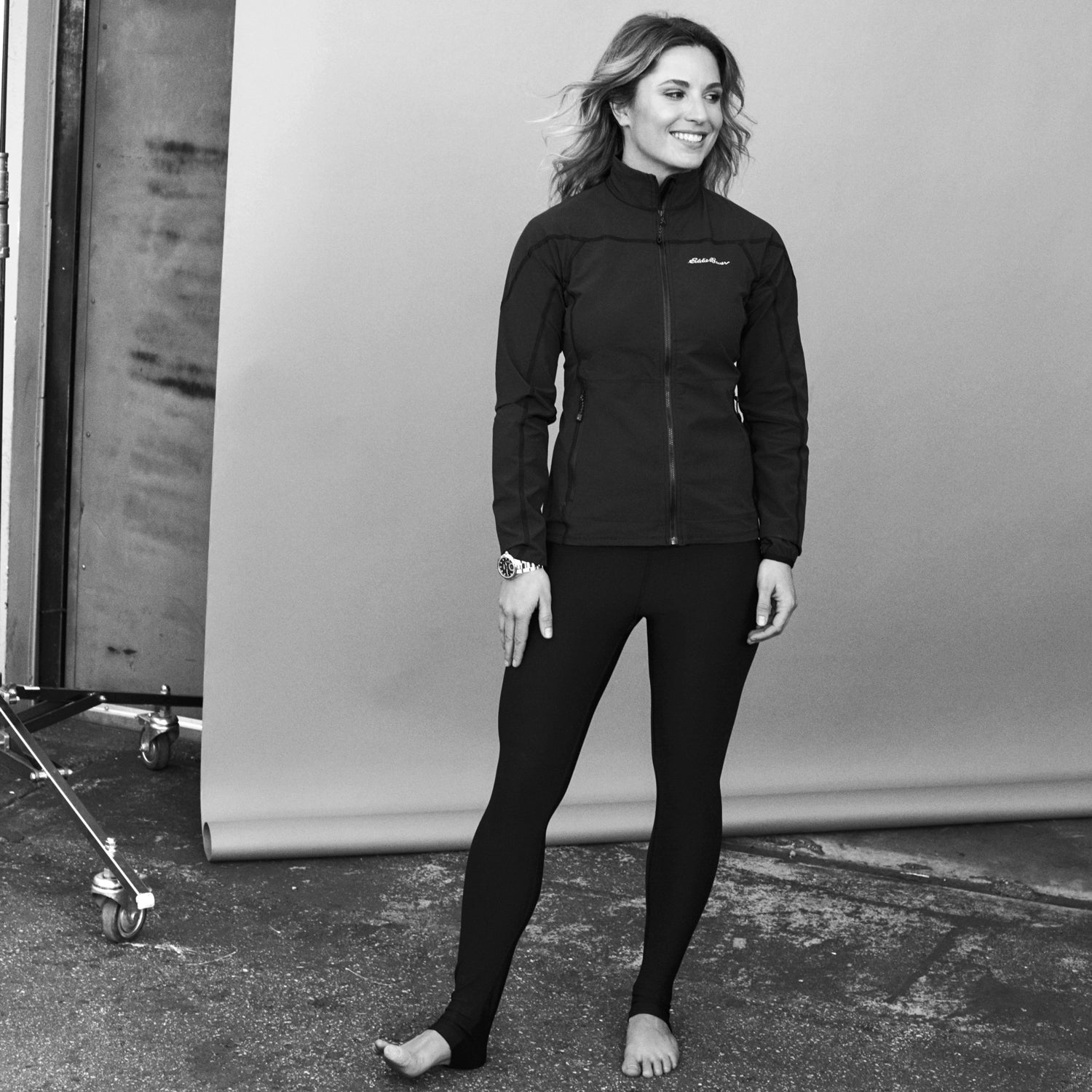In 2005, at the end of Melissa Arnot ReidŌĆÖs first month working as a guide for , the 21-year-old walked into her bossŌĆÖs office to quit.
That month offered both an introduction to guidingŌĆöshe was leading clients to Mount RainierŌĆÖs 14,410-foot summitŌĆöand to the misogyny thatŌĆÖs present for many women working in male-dominated fields.
There was the client who wouldnŌĆÖt call her by name, instead referring to her as ŌĆ£Hotcakes,ŌĆØ and the climbers who refused to be on her rope team because she was a woman. ŌĆ£I felt phenomenally disrespected,ŌĆØ she says. ŌĆ£I went to my bossŌĆØŌĆöRMI operations manager Jeff MartinŌĆö ŌĆ£and told him, ŌĆśI donŌĆÖt know if this is for me.ŌĆÖ He encouraged me to stick it out, that it would get better. He was right.ŌĆØ
Arnot Reid has worked as a guide ever since, for RMI and other outfitters, and for her own guiding service, which she started in 2010. She takes clients up Rainier, Aconcagua, and Everest, among other peaks. In the past decade, Arnot ReidŌĆöwho is now 33 and married to fellow RMI guide Tyler ReidŌĆöhas become one of the best in the world at what she does, which, if you ask her, is walking uphill slowly. She has summited Everest six times, more than any other American woman. Her most recent ascent, last spring, was without the aid of supplemental oxygenŌĆösomething that only 165 people, seven of them women, have done. She is the first American woman to do so and survive the descent.
ItŌĆÖs a testament to her incredible athletic strength, both mental and physical. ŌĆ£Everest can be an emotional roller coaster and a physical meat grinder,ŌĆØsays frequent Everest summiter and RMI guide Dave Hahn.ŌĆ£It smacks a lot of up-and-coming guides in the face with harsh realities about personal limitations. I donŌĆÖt remember that shock ever hitting Melissa. She was in her element from the start. And climbing to 29,000 feet without oxygen is ridiculously physically hard.ŌĆØ
The XX Factor Issue
 Our special issue highlights the athletes, activists, and icons who have shaped the outside world.
Our special issue highlights the athletes, activists, and icons who have shaped the outside world.If you follow Everest headlines, you may have read about Arnot Reid for another reason. In 2013, she broke up the now infamous fight between European alpinists Ueli Steck, Simone Moro, and Jon Griffith and a group of Sherpas. The cause of the altercation remains unclear, but the fight escalated to violence at Camp II, where Arnot Reid stepped inŌĆöliterally. She put her body between the Sherpas and the Europeans and proceeded to facilitate an hourlong negotiation.
It was a successful move because of the respect Sherpas have for women and specifically for Arnot Reid, who has been working to help them over the past few years, after an accident in 2010. Arnot Reid was on an expedition to climb NepalŌĆÖs 23,389-foot Baruntse with veteran Sherpa Chhewang Nima when he fell to his death. A cornice collapsed while he was fixing ropes high on the mountain. Her intimate knowledge of what happens to families after SherpasŌĆöusually the householdŌĆÖs sole breadwinnersŌĆödie at work compelled Arnot Reid, along with climber and guide David Morton, to start the in 2012. Today the nonprofit provides financial assistance and vocational training to 37 families, including Chhewang NimaŌĆÖs.
Arnot Reid grew up poor on the outskirts of the Southern Ute Indian Reservation near Durango, Colorado, where her father and mother, who worked as a ski patroller and an administrative assistant, respectively, emphasized outdoor activities. They werenŌĆÖt ones to force the college-to-cubicle route. Grit, however, was nonnegotiable. At 13, Arnot Reid was cleaning hotel bathrooms for money. By 16, she had finished high school and moved out of her parentsŌĆÖ house. ŌĆ£I was fully responsible for my own survival,ŌĆØ she says. ŌĆ£I had no safety net. ItŌĆÖs not that my family wouldnŌĆÖtŌĆöthey couldnŌĆÖt.ŌĆØ SheŌĆÖs been supporting herself ever since.
In 2002, after graduating from the at 18, she moved to MontanaŌĆÖs Flathead Valley and summited a peak for the first time, near . ŌĆ£ThatŌĆÖs when I really saw the mountains and decided to pursue climbing,ŌĆØ she says. Later that summer, she came across a rescue mission for an injured climber while descending a technical peak in Glacier and ended up helping. ŌĆ£It made me acutely aware of how little I knew in terms of rescue and first aid, and how when something goes wrong it can go really wrong,ŌĆØ she says. The climber died. Afterward, Arnot Reid decided to pursue a career in medicine and guiding. She moved into her truck and got certified as a Wilderness First Responder and an EMT in Montana. A couple of years later, she landed the job with RMI.
She put her body between the Sherpas and the Europeans and proceeded to facilitate an hourlong negotiation.
In 2007, RMI client Jeff Dossett saw Arnot Reid respond to a rescue on Rainier and was impressed by her skills. He asked her to guide him on Everest. She was 23, much younger than most of the male guides on the mountain, and had never climbed in the Himalayas. ŌĆ£ItŌĆÖs a double-edged sword being a woman in any hyper-male-dominated industry,ŌĆØshe says.ŌĆ£YouŌĆÖre an outlier, and outliers are interesting, so you get opportunities that maybe your equally skilled male counterparts wouldnŌĆÖt. IŌĆÖve been the beneficiary of that. The other side of it is this knowledge that perhaps youŌĆÖve been given an opportunity because youŌĆÖre the diversity quota, the lone woman, and you have to work twice as hard to establish that you deserve the spot.ŌĆØ
ThatŌĆÖs exactly what she did. ŌĆ£I didnŌĆÖt want to be the best girl guide. I wanted to be the best guide,ŌĆØ she says.
Arnot Reid became sponsored in 2008, something more common among expedition-style climbers. She is currently an . There arenŌĆÖt many other female guides at Arnot ReidŌĆÖs level on Everest; the only one she sees regularly on the mountain is Kiwi guide Lydia Bradey.
Arnot Reid says that one of the biggest challenges she has faced in her career has nothing to do with climbing. As she gained more experience, her confidence grew and respect from other climbers followed. But some of the behavior in the mountaineering community has remained difficult at times.
ŌĆ£I have dealt with such a widespread and continuous presence of sexual harassment that ranges from comments to really inappropriate touching and attempts to pursue further physical contact that I didnŌĆÖt want,ŌĆØ she says. ŌĆ£I didnŌĆÖt see that happening to my male counterparts, and I wanted the same freedom. I have been thinking a lot about how much IŌĆÖve put up with and how my silence has helped keep that negative culture going.ŌĆØ
In 2008, during her first season on Everest, she and Morton were working with the outfitter to guide Dossett, who was climbing the mountain for a second time to bring awareness to AfricaŌĆÖs HIV/AIDS crisis. Dossett had brought Arnot Reid along for her expertise and to help her pursue a career in the Himalayas. ŌĆ£I hired Melissa on my Everest expedition team purely out of respect for her guiding and EMT skills, her work ethic, and her extraordinary potential as an elite mountain guide and climber,ŌĆØ Dossett says. ŌĆ£She ultimately proved beyond a shadow of a doubt that she deserved that opportunity regardless of her gender.ŌĆØ
But there were whispers around Base Camp that Dossett wanted Arnot Reid there for other reasons. ŌĆ£That felt horrible,ŌĆØ she says. ŌĆ£I never had anything but a professional relationship with him, and I hated that people thought otherwise.ŌĆØ
ThereŌĆÖs an Ani DiFranco song that goes, But the same rule always applies / Smile pretty and watch your back. That became Arnot ReidŌĆÖs mantra in those situationsŌĆökeep a soft presence, but be quietly discontent. Ultimately, what she learned was that you canŌĆÖt make people respect you, and the pursuit of that end isnŌĆÖt worth the energy. ŌĆ£IŌĆÖve been in situations where I know the person doesnŌĆÖt like me, but IŌĆÖm the gatekeeper of their safety and I want them to feel safe,ŌĆØshe says.ŌĆ£ThatŌĆÖs my biggest concern, more than if they like me.ŌĆØ
ŌĆ£I didnŌĆÖt want to be the best girl guide. I wanted to be the best guide,ŌĆØ she says.
Now sheŌĆÖs working to create a place for the next generation of female climbers. This spring, sheŌĆÖs heading to NepalŌĆÖs Annapurna region with her client Elliot Singer, a 15-year-old American girl who Arnot Reid wants to teach how to be a strong climbing partner. SheŌĆÖs also mentoring 22-year-old Sun Valley, Idaho, native Maddie Miller, an aspiring mountain guide. Arnot Reid thinks itŌĆÖs important to show young people that you can have a successful career in the outdoors on a nontraditional path.ŌĆ£ItŌĆÖs not just being a dirtbag mountain guide,ŌĆØ she says.
Last spring, Miller set the new speed record for climbing the 50 highest points in all 50 states, a mission that took 41 mostly sleepless days, 19,000 miles of driving, and a lot of Subway sandwiches. Arnot Reid was with her for all of the ascents except Denali, which she had to skip because of a foot injury sustained on Everest.ŌĆ£IŌĆÖm trying to teach these girls that the hard work is what youŌĆÖre proud of,ŌĆØ she says. ŌĆ£ItŌĆÖs not all records and summits.ŌĆØ
Arnot Reid and her husband now live in Winthrop, Washington, a tiny gateway town to . With her personal Everest dreams finally realized, sheŌĆÖs putting the focus back on helping clients tackle theirs. SheŌĆÖs also stepping up her role at the Juniper Fund. In January, she had just returned from Nepal, where the fundŌĆÖs vocational-training program has produced five businesses, including a chicken farm and two successful Kathmandu restaurants run by Nepali widows.
Looking back on it all, thereŌĆÖs another reason why Arnot Reid didnŌĆÖt quit during that first season. ŌĆ£I knew that if I walked away, no one was going to change,ŌĆØ she says. ŌĆ£And maybe they wouldnŌĆÖt change if I stayed, but maybe I could make it a little bit harder for them to treat women that way in the future.ŌĆØ


